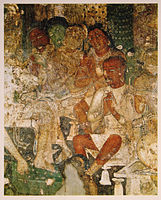Murals of sorts date to Upper Paleolithic times such as the cave paintings in the Lubang Jeriji Saléh cave in Borneo (40,000-52,000 BP), Chauvet Cave in Ardèche department of southern France (around 32,000 BP). Many ancient murals have been found within ancient Egyptian tombs (around 3150 BC), the Minoan palaces (Middle period III of the Neopalatial period, 1700–1600 BC), the Oxtotitlán cave and Juxtlahuaca in Mexico (around 1200-900 BC) and in Pompeii (around 100 BC – AD 79).
During the Middle Ages murals were usually executed on dry plaster (secco). The huge collection of Kerala mural painting dating from the 14th century are examples of fresco secco. In Italy, circa 1300, the technique of painting of frescos on wet plaster was reintroduced and led to a significant increase in the quality of mural painting.
In modern times, the term became more well known with the Mexican muralism art movement (Diego Rivera, David Siqueiros and José Orozco). There are many different styles and techniques. The best-known is probably fresco, which uses water-soluble paints with a damp lime wash, rapid use of the resulting mixture over a large surface, and often in parts (but with a sense of the whole). The colors lighten as they dry. The marouflage method has also been used for millennia.
Murals today are painted in a variety of ways, using oil or water-based media. The styles can vary from abstract to trompe-l’œil (a French term for “fool” or “trick the eye”). Initiated by the works of mural artists like Graham Rust or Rainer Maria Latzke in the 1980s, trompe-l’oeil painting has experienced a renaissance in private and public buildings in Europe. Today, the beauty of a wall mural has become much more widely available with a technique whereby a painting or photographic image is transferred to poster paper or canvas which is then pasted to a wall surface (see wallpaper, Frescography) to give the effect of either a hand-painted mural or realistic scene.
A special type of mural painting is Lüftlmalerei, still practised today in the villages of the Alpine valleys. Well-known examples of such façade designs from the 18th and 19th centuries can be found in Mittenwald, Garmisch, Unter- and Oberammergau.

